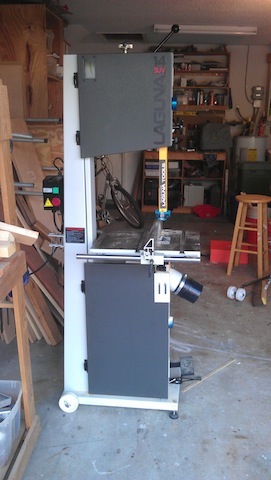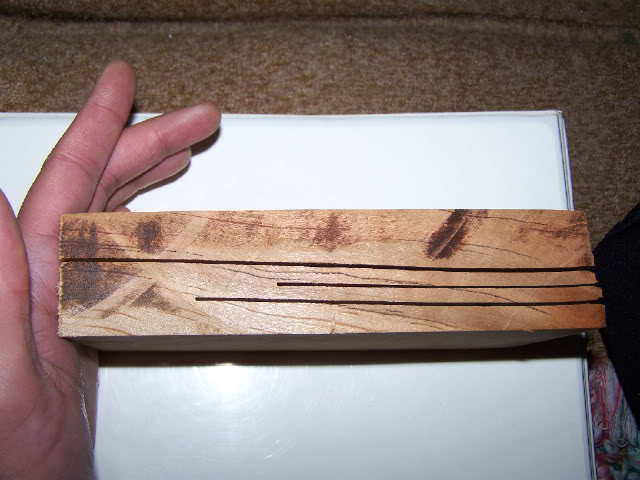My new Laguna band saw is awesome. It has plenty of power, a huge table and lots of other features that make it a dream to work with.

The only problem? It’s a band saw, and that means you just can’t throw a blade on the sucker and start cutting. There are adjustments that have to be made in order to get the saw to work properly. And, that’s OK with me, it just becomes a little tedious.
One of the most important adjustments on the saw is to get the blade to track right in the middle of the upper and lower wheels. If the blade is to far forward or too far back, it will tend to drift – or start cutting out of square in relation to the rip fence. Some drift is OK, but if the drift seems totally out of whack – like you have to angle the workpiece excessively in order to cut a straight line – you are going to have issues ever trying to get a decent cut.
The recommended method to check for blade drift is to get a piece of wood, mark a straight line on the piece, feed it through freehand until you get about halfway through the cut, stop the saw and then mark that angle so you can adjust the fence to make up for the drift. This drift can be reduced, again, by getting the blade to track on the center of the wheel.
And, that’s where my trouble begins. I would eyeball the blade on the wheel to see if it was centered on the wheel. And, that worked OK, but I was never really jazzed with my eyeballing. What I needed to do was to get the blade in the middle of the wheel for certain. But, how was I going to get that accuracy?
That’s when I stumbled across this method on the Lumberjocks site. User Stefang used an interesting tool to get the blade centered – his calipers. It’s a very simple method that is so elementary, you will end up slapping your forehead in one of those ‘duh’ moments.
First, you use your caliper to measure the width of the the upper wheel. From hub to hub, my band saw wheel is 1.2 inches wide. That is verified by my decimal calipers.
In this case, I know my resaw blade is .75 inches wide. Now, let’s do some simple math (oh, man, you are going to make this English major do math?):
1.2 inches (wheel width) – .75 inches (blade width) = .45 inches
This .45 inches is what remains from front face to back face of the wheel that isn’t covered by blade. From there, if I want to make this blade centered on the wheel, I have to divide that in half. So…
.45 inches / 2 = .225 inches
Now, this means if I have .225 inches from the front hub of the wheel to the front teeth on the saw blade, bingo bango, chimi chang chango, I’m right on the middle. By adjusting the tracking wheel on the saw and rotating the upper wheel by hand, I was able to get the blade right in the middle. No fuss, no muss.
When I made my cut with the saw, it wasn’t 100% on the money. There was still a drift. But, wow, did that drift nearly disappear. And, when I popped a piece up on the saw to resaw it, the saw behaved beautifully.
OK, maybe math isn’t my strong suit, but using a little bit of it, I might be able to make my woodworking just a little better.



Holy cow! What a great idea!
I’m going to have to try that.
My old, old, old saw behaves like it is possessed, and you wouldn’t believe the angle I have to cut at sometimes to compensate for the drift! ha ha
If I spend half a day adjusting everything, it’ll work OK.
(until I have to change the blade again…groan..)
I swear when I turn it on, I hear it laugh at me…
Stefang’s method HAS to be easier then going to see the warden about a new saw…..lol
Thanks Tom & Stefang.
A great and perfectly sound theory. Now what about the demonstration I’ve seen that suggests, rather convincingly, that the correct position of the blade on the wheel is not to center the entire blade on the wheel but instead the base of the gullet? There’s a video somewhere, I think from a WIA show, of the guy from Carter Products demonstrating the set-up of a band saw and the results of his set-up were outstanding based on this set-up technique. He argued, and showed, that with this set up one should never have to adjust for drift. It’s been too cold here for me to try for myself …
Someone shared that video with me today… I guess I’ll have to play around with position…
Tom the only way that works (putting the bottom of the gullet centered on the wheel) is if you are using Carter guides. I have them and it works really good. After seeing your tip I wanted to try it but can’t with Carter’s equipment.